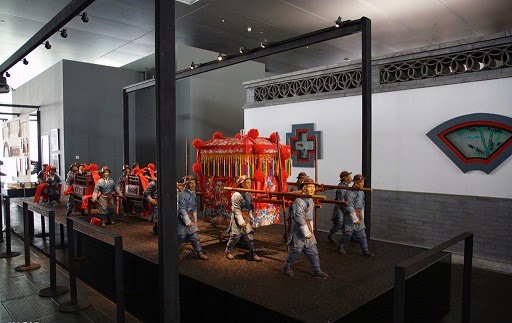The Beijing
National Stadium, also known as the "Bird's Nest", is located at the
southern part of the Olympic Green in Beijing,
in the northeast of the city. As the main stadium for the 29th Olympiad in
2008, the National Stadium covers an area of 258,000 square meters (64 acres)
and accommodates a maximum of 91,000 spectators with a permanent capacity of
80,000.

Located at the
Olympic Green, the stadium cost US428 million. The design was awarded to a
submission from the Swiss architecture firm Herzog & de Meuron in April
2003 after a bidding process that included 13 final submissions. The design,
which originated from the study of Chinese ceramics, implemented steel beams in
order to hide supports for the retractable roof; giving the stadium the
appearance of a bird's nest. Leading Chinese artist Ai Weiwei was the artistic
consultant on the project. The retractable roof was later removed from the
design after inspiring the stadium's most recognizable aspect. Ground was
broken on 24 December 2003 and the stadium officially opened on 28 June 2008. A
shopping mall and a hotel are planned to be constructed to increase use of the
stadium, which has had trouble attracting events, football and otherwise, after
the Olympics.

The stadium looks
like a nest from the outside, symbolizing a cradle holding the hopes of mankind
for the future. The main body of the National Stadium is a colossal
saddle-shaped elliptic steel structure weighing 42,000 tons. It is 333 meters
(1092 feet) long from north to south, 294 meters(964 feet) wide from east to
west, and 69 meters (226 feet) tall. The stadium was designed to remain
functional for 100 years. Its fire resistance capability is first-rate, and it
can withstand an eight-magnitude earthquake.
The spatial effect
of the stadium is radical and yet simple and of an almost archaic immediacy.
There is no exterior facade. But it lies open and exposed to allow for natural
ventilation of the stadium, which is the most important aspect of the stadium's
design. The main body's elements support each other and converge into a grid
formation, almost like the interlocking branches and twigs of a bird's nest.
The design meets all the functional and technical requirements of an Olympic
Stadium, but without communicating the insistent sameness of technocratic
architecture dominated by large spans and digital screens.

The Bird’s Nest is
a complex structure that posed great difficulties for its designers and
constructors. The workers had to overcome tremendous engineering and technical
challenges in the process of construction. Because of the limited time to
finish construction, workers had to defy both rainy and cold conditions in the
winter to continue their work. The huge workload combined with the short timeframe
caused a lot of tension. But finally the project that was started on December
24, 2003, was eventually completed in June, 2008, just in time for the Olympic
Games.
The eastern and
western stands of Beijing National Stadium are higher than northern and
southern stands, in order to improve sightlines. A 24-hour per day rainwater
collector is located near the stadium; after water is purified, it is used
throughout and around the stadium. Pipes placed under the playing surface
gather heat in the winter to warm the stadium and coldness in the summer to
cool the stadium. The stadium's design originally called for a capacity of
100,000 people; however 9,000 were removed during a simplification of the
design. The new total of 91,000 would be shaved further when 11,000 temporary
seats were removed after the 2008 Olympics; bringing the stadium's capacity to
80,000. The farthest seat is 460 feet (140 meters) from center field.
Temperature and airflow of every surface were optimized to increase
ventilation.

Beijing National
Stadium hosted the Opening and Closing Ceremonies, athletic events, and
football final of the 2008 Summer Olympics from 8 to 24 August 2008. The
stadium also hosted the Opening and Closing ceremonies and athletic events of
the 2008 Summer Paralympics from 6 to 17 September 2008. Though designed for
track & field events of the Olympics, the stadium will continue to host
sporting events, such as football, afterwards. A shopping mall and a hotel,
with rooms overlooking the field, are planned to help increase use after the
Olympics.





































